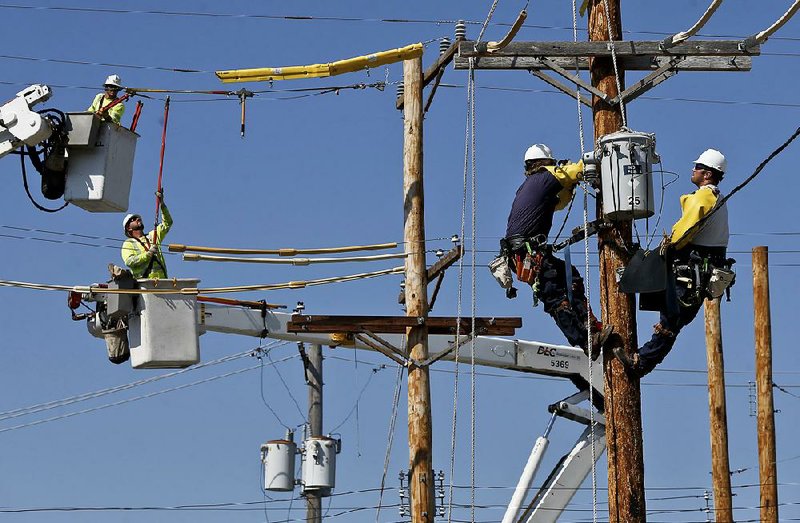WASHINGTON -- The pace of hiring in the United States quickened in August, and wages grew at their fastest pace in nine years -- evidence that employers remain confident despite ongoing conflicts between President Donald Trump's administration and its trading partners.
The economy added a strong 201,000 jobs, and the unemployment rate stayed at 3.9 percent, near an 18-year low, the government said Friday in its monthly jobs report.
Taken as a whole, the data pointed to a job market that remains resilient even after nearly a decade of economic growth -- the second-longest such stretch in U.S. history -- and even with tariffs and counter-tariffs on imports and exports looming over U.S. employers that rely on global trade.
The economy is expanding at a healthy pace, fueled by tax cuts, confident consumers, greater business investment in equipment and more government spending. Growth reached 4.2 percent at an annual rate in the April-June quarter, the fastest pace in four years.
"I view this as the strongest job market in a generation," Andrew Chamberlain, chief economist at Glassdoor, a career website.
Even while reporting a robust job gain for August, the Labor Department revised sharply down its estimate of hiring in June and July. The government now says employers added 50,000 fewer jobs in those two months combined than it had previously estimated.
But the 201,000 job gain in August was nearly equal to the average gain of 196,000 over the previous 12 months, evidence of how consistent job growth remains.
Average hourly pay jumped 0.4 percent in August and increased 2.9 percent compared with a year earlier. That's the fastest annual gain since June 2009, when the last recession ended. Still, rising inflation, which also reached 2.9 percent in July from a year earlier, has offset that gain.
Yet, most economists said they saw the pay increase as an encouraging sign that the low unemployment rate is compelling more employers to raise pay in order to compete successfully for workers.
"It looks like we're finally seeing that acceleration in wage growth that we've been waiting for," said Gus Faucher, chief economist at PNC Financial Services. "It's good news for workers' paychecks, it's good news for consumers and it's good news for the overall economy."
The rising wage and jobs data make it a near-certainty that the Federal Reserve will raise short-term interest rates when it meets later this month, economists said. Most Fed watchers also expect another rate increase in December and perhaps two more next year.
Jason Mazzarone, chief executive of SoBol, a restaurant chain that sells a variety of acai bowls, says he is paying workers more, mostly because of higher minimum-wage laws in New York and other states where his 26-store chain operates. He also has raised pay for other workers who were already earning more than the minimum.
On New York's Long Island, for example, where many of his outlets are, the minimum wage will reach $12 an hour by year's end. For shift managers now making $16 an hour, Mazzarone said, "their pay has to go up, too."
The Trump administration has imposed tariffs on imported steel and aluminum as well as on $50 billion of goods from China and is threatening far more. U.S. companies across a range of industries have expressed alarm about those import taxes and about counter-tariffs that other nations have imposed on U.S. exports.
Yet so far, there are few signs that those concerns have affected overall hiring.
Manufacturers cut 3,000 jobs last month, the first time they have cut jobs in about a year. Factories have taken the most direct hit from higher tariffs, with automakers, aerospace, and machinery companies absorbing higher steel and aluminum costs. Automakers accounted for all the losses, cutting nearly 5,000 jobs.
Still, those losses might not fully reflect trade disruptions. Automakers typically retool their factories for new model year cars over the summer, which can temporarily distort the job figures.
Friday's jobs report showed that professional and business services, a category that includes both higher-paying fields such as engineering and accounting and lower-paying temp jobs, led August's job growth with 53,000 added positions. Health care providers added 33,000 and transportation and warehousing companies 20,200, the most in nearly a year.
The loss of 3,000 manufacturing jobs is the industry's worst showing in more than a year. Retailers cut 6,000 positions, a surprising drop given reports of strong sales by such leading retailers as Target, Walmart and Best Buy.
Most analysts have forecast that the economy will expand at an annual pace of at least 3 percent in the current July-September quarter. For the full year, the economy is on track to grow 3 percent for the first time since 2005.
In August, factories expanded at their quickest pace in 14 years, according to a survey of purchasing managers. A manufacturing index compiled by a trade group reached its highest point since 2004.
Not all the economic news has been positive. Higher mortgage rates and years of price increases are slowing the housing market. Sales of existing homes dropped in July for a fourth-straight month.
Business on 09/08/2018

